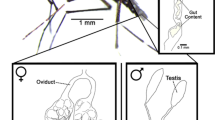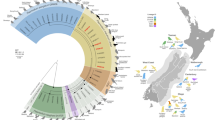Abstract
During the last two decades, Belarus faces an increase of human cases of Dirofilaria (Nematoda, Spirurida, Onchocercidae) infections. However, comprehensive analyses explaining this development and the identification of mosquito vector species are missing. Here, we present results using temperature data from Belarus and show that the annual number of human Dirofilaria cases is significantly correlated with the yearly average temperatures (Spearman’s rho = 0.49, p < 0.05) and the average sum of potential Dirofilaria transmission days (Spearman’s rho = 0.46, p < 0.05), suggesting that autochthonous transmission is at least in part responsible for the increasing number of clinical Dirofilaria cases in the country. In addition, 467 female mosquitoes were collected from different sampling sites in the regions of Brest and Minsk, which were analyzed by molecular methods for the presence of Dirofilaria repens and Dirofilaria immitis DNA, respectively. Two pools (5.56 %) were tested positive for Dirofilaria (estimated infection rate per 100 specimens = 0.44, 95 % confidence interval = 0.08–1.43), comprising one Anopheles claviger s.l. pool that was positive for D. repens and one Culex pipiens s.l./Culex torrentium pool positive for D. immitis DNA. This, to our knowledge, is the first molecular evidence for the presence of Dirofilaria in mosquitoes from Belarus, suggesting a high probability of autochthonous Dirofilaria transmission in the country.


Similar content being viewed by others
References
Becker N, Petrić D, Zgomba M, Boase C, Madon M, Dahl K, Kaiser A (2010) Mosquitoes and their control, 2nd edn. Springer, Heidelberg
Bocková E, Rudolf I, Kočišová A, Betášová L, Venclíková K, Mendel J, Hubálek Z (2013) Dirofilaria repens microfilariae in Aedes vexans mosquitoes in Slovakia. Parasit Res 112:3465–3470
Bocková E, Iglódyová A, Kočišová A (2015) Potential mosquito (Diptera:Culicidae) vector of Dirofilaria repens and Dirofilaria immitis in urban areas of Eastern Slovakia. Parasit Res 114:4487–4492
Borkowski PK, Rymkiewicz G, Golebiewska J, Nestoros N, Romejko-Jarosinska J, Zarnowska-Prymek H, Masny A, Palucki J, Cielecka D (2014) The first case of human autochtonous subconjunctival dirofilariosis in Poland and MALT lymphoma as possible consequence of this parasitosis. Infect Agents Cancer 10:1. doi:10.1186/1750-9378-10-1
Bronshteyn AM, Malyshev NA, Jarov SN, Fedianina LV, Frolova АА, Supriaga VG, Luchshev VI (2013) A first autochthonous human case of the long standing microfilaraemia due to Dirofilaria repens in Russia and a first experience of combined therapy of dirofilariasis repens. Epidemiol Infect Dis 3:47–52 (in Russian)
Cancrini G, Kramer L (2001) Insect vectors of Dirofilaria spp. In: Simón F, Genchi C (eds) Heartworm infection in humans and animals. Universidad de Salamanca, Salamanca, pp 63–82
Carpova GN (2010) Physical geography of Belarus: a course of lectures, 2nd edn. Gomel State University, Gomel (in Russian)
Chistenko GN, Vedenkov AL, Dronina AM, Semizhon OA (2013) Human dirofilariasis. Med Jurnal 3:30–33 (in Russian)
Cielecka D, Żarnowska-Prymek H, Masny A, Salamatin R, Wesołowska M, Gołąb E (2012) Human dirofilariasis in Poland: the first cases of autochthonous infections with Dirofilaria repens. Ann Agric Environ Med 19(3):445–450
Fedianina LV (2010) Human dirofilariasis in Russia. Med Parazitol 2:43–44 (in Russian)
Fedianina LV, Frolova AA, Pliushcheva GL, Chernyshenko AI, Morozov EN, Rakova VM (2011) Cases confirming the concept that the human being is a facultative host of Dirofilaria repens. Med Parazitol 4:37–38 (in Russian)
Fedianina LV, Shatova SM, Rakova VM, Shaĭtanov VM, Lebedeva MN, Frolova AA, Morozov EN, Morozova LF (2013) Microfilaraemia in human dirofilariasis caused by Dirofilaria repens Raiet et Henry, 1911. A case report. Med Parazitol 2:3–7, in Russian
Genchi C, Rinaldi L, Cascone C, Mortarino M, Cringoli G (2005) Is heartworm disease really spreading in Europe? Vet Parasitol 133:137–148
Haylock MR, Hofstra N, Klein Tank AMG, Klok EJ, Jones PD, New M (2008) A European daily high-resolution gridded dataset of surface temperature and precipitation. J Geophys Res Atmos 113:D20119
Kartashev V, Tverdokhlebova T, Korzan A, Vedenkov A, Simón L, Gonzalez-Miguel J, Morchón R, Siles-Lucas M, Simón F (2015) Human subcutaneous/ocular dirofilariasis in the Russian Federation and Belarus, 1997–2013. Int J Infect Dis 33:209–211
Mantovani A, Restani R (1965) Ricerche sui possibili artropodi vettori di Dirofilaria repens in alcune provincie dell Italia céntrale. Parassitologia 7:109–116
Melbarde-Gorkusa I, Abolins A, Strumfa I, Martinsons A, Gardovskis J (2011) Human dirofilariasis in Latvia—the first case in surgical practice. Acta Chir Latv 11:172–174
(MHRB) Ministry of Health of the Republic of Belarus 2014. Instruction on the prevention of dirofilariasis. Borisov Zonal Center of Hygiene and Epidemiology. http://www.gigbor.by/Norm_doc/TNPA/paraziti.doc. Accessed 29 Dec 2015 (in Russian)
Naralenkova E (2004) Notification of cases of dirofilariasis in the Gomel region. Med Parazitol 2:49–51 (in Russian)
Otranto D, Dantas-Torres F, Brianti E, Traversa D, Petrić D, Genchi C, Capelli G (2013) Vector-borne helminths of dogs and humans in Europe. Parasit Vectors 6:16. doi:10.1186/1756-3305-6-16
Pampiglione S, Rivasi F (2000) Human dirofilariasis due to Dirofilaria (Nochtiella) repens: an update of world literature from 1995 to 2000. Parassitologia 42:231–254
Pantchev N, Norden N, Lorentzen L, Rossi M, Rossi U, Brand B, Dyachenko V (2009) Current surveys on the prevalence and distribution of Dirofilaria spp. in dogs in Germany. Parasit Res 105:63–74
Pantchev N, Etzold M, Daugschies A, Dyachenko V (2011) Diagnosis of imported canine filarial infections in Germany 2008–2010. Parasit Res 109:61–76
Poppert S, Hodapp M, Krüger A, Hegasy G, Niesen WD, Kern WV, Tannich E (2009) Dirofilaria repens infection and concomitant meningoencephalitis. Emerg Infect Dis 15:1844–1846
R Core Team. R (2015) A language and environment for statistical computing [Internet]. R Foundation for Statistical Computing, Vienna, http://www.R-project.org/ Accessed 1 Dec 2015
Rudolf I, Šebesta O, Mendel J, Betášová L, Bocková E, Jedličková P, Venclíková K, Blažejová H, Šikutová S, Hubálek Z (2014) Zoonotic Dirofilaria repens (Nematoda: Filarioidea) in Aedes vexans mosquitoes, Czech Republic. Parasit Res 113:4663–4667
Sałamatin RV, Pavlikovska TM, Sagach OS, Nikolayenko SM, Kornyushin VV, Kharchenko V, Masny A, Cielecka D, Konieczna-Sałamatin J, Conn DB, Golab E (2014) Human Dirofilaria repens infection in Ukraine (1997–2013). In: Fok E, Kucsera I (eds) Fourth European Dirofilaria and Angiostrongylus Days. Hungarian Society of Parasitologists, Budapest, p 80
Sassnau R, Genchi C (2013) Qualitative risk assessment for the endemisation of Dirofilaria repens in the state of Brandenburg (Germany) based on temperature-dependent vector competence. Parasit Res 112:2647–2652
Sassnau R, Czajka C, Kronefeld M, Werner D, Genchi C, Tannich E, Kampen H (2014) Dirofilaria repens and Dirofilaria immitis DNA findings in mosquitoes in Germany: temperature data allow autochthonous extrinsic development. Parasit Res 113:3057–3061
Schaffner F, Angel G, Geoffrey B, Hervy J-P, Rhaiem A, Brunhes J (2001) The mosquitoes of Europe. CD-ROM. Institut de Recherche pour le Développement/Entente interdépartementale pour la démoustication du littoral (EID) Méditerrannée, Montpellier
Sergiev VP, Supriaga VG, Morozov EN, Zhukova LA (2009) Human dirofilariasis: diagnosis and the pattern of pathogen-host relations. Med Parazitol 3:3–6 (in Russian)
Shimalov VV, Pen’kevich VA (2012) Helminth fauna of the wolf (Canis lupus Linnaeus, 1758) in Belorussian Polesie. Parazitologiia 46:118–126 (in Russian)
Simón F, Siles-Lucas M, Morchón R, González-Miguel J, Mellado I, Carretón E, Montoya-Alonso JA (2012) Human and animal dirofilariasis: the emergence of a zoonotic mosaic. Clin Microbiol Rev 25:507–544
Tappe D, Plauth M, Bauer T, Muntau B, Dießel L, Tannich E, Herrmann-Trost P (2014) A case of autochthonous human Dirofilaria infection, Germany, March 2014. Euro Surveill 19:2–4
Tasić A, Rossi L, Tasić S, Miladinović-Tasić N, Ilić T, Dimitrijević S (2008) Survey of canine dirofilariasis in Vojvodina, Serbia. Parasit Res 103:1297–1302
Tereshkina NV, Truhan MN, Kaplich VM (1998) Distribution of bloodsucking dipterous insects (Diptera: Culicidae, Simuliidae, Tabanidae) in ecosystems of Polesie State Radiation Ecological Reserve. In: Parfenov VI (ed). The 10th anniversary of the Polesie State Radiation Ecological Reserve. Minsk. pp. 179–182 (in Russian)
Volkova TV (2008) The mosquitoes (Diptera, Culicidae) of urban landscapes of Belarus. Dissertation, Institute of Zoology of NAS Belarus (in Russian)
Volkova TV, Tereshkina NV (2009) Peculiarities of the mosquito larval (Diptera, Culicidae) biotope distributions in urban areas of Belarus. Vestnik MSU 1:13–14 (in Russian)
Volkova TV, Aksenova EA, Yashkova SE (2013) The current state of knowledge of the mosquitoes from the genus Anopheles (Diptera, Culicidae) in Belarusian Polesie. In: Medvedev SG (ed) Fundamental and applied aspects of study the parasitic arthropods in the XXI century. Zoological Institute RAS, St. Petersburg, pp 49–52 (in Russian)
Zhang B, Bilder C, Biggerstaff B, Schaarschmidt F (2012) binGroup: evaluation and experimental design for binomial group testing. http://CRAN.R-project.org/package=binGroup. Accessed 1 Dec 2015
Acknowledgments
This work was partially supported by EurNegVec COST Action TD1303. We acknowledge the E-OBS dataset from the EU-FP6 project ENSEMBLES (http://ensembles-eu.metoffice.com) and the data providers in the ECA&D project (http://www.ecad.eu).
Author information
Authors and Affiliations
Corresponding author
Rights and permissions
About this article
Cite this article
Șuleșco, T., Volkova, T., Yashkova, S. et al. Detection of Dirofilaria repens and Dirofilaria immitis DNA in mosquitoes from Belarus. Parasitol Res 115, 3535–3541 (2016). https://doi.org/10.1007/s00436-016-5118-y
Received:
Accepted:
Published:
Issue Date:
DOI: https://doi.org/10.1007/s00436-016-5118-y




